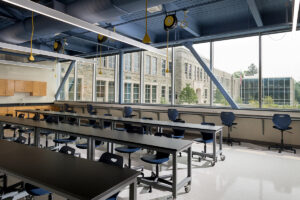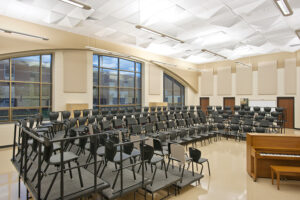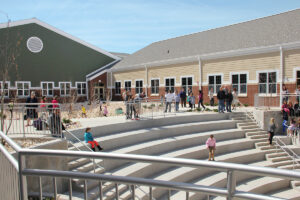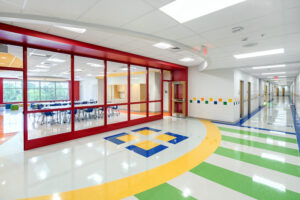
Thirteen thousand hours.
That’s how long the average student will spend in school throughout their K-12 education.
For decades, educational institutions have focused on providing safe and clean environments for learning. But we now understand buildings can do more – they can actively support how students learn, think and grow. This revelation is transforming educational design.
A growing body of research suggests environments designed to foster student health contribute to reduced absenteeism and enhanced performance.
Drawing from our experience designing healthy schools, we’re sharing some key considerations for your facility. When you’re ready to explore solutions tailored to your district’s specific needs, our team is here to help.
Natural Light
Years ago, teachers may have lamented windows in classrooms, viewing them as a source of distraction for students. But recent studies suggest this line of thought is wrong.
 Our bodies are designed to respond to natural light cycles. Integrating daylighting strategies into school design, we tap into students’ natural circadian rhythms. Instead of encouraging wandering eyes and daydreaming, access to natural light improves focus, mood and learning retention.
Our bodies are designed to respond to natural light cycles. Integrating daylighting strategies into school design, we tap into students’ natural circadian rhythms. Instead of encouraging wandering eyes and daydreaming, access to natural light improves focus, mood and learning retention.
Research indicates that proper daylighting can increase student progress rates by 20-26% in reading and mathematicsi.
Creating optimal natural light requires a multifaceted approach. Methods include:
- Carefully positioned windows and light shelves that direct sunlight deeper into classrooms.
- Solar tubes that provide natural light to interior rooms.
- Automated shading systems that prevent glare while maintaining light levels.
- Clerestory windows that allow for deep penetration of natural light.
- Light-colored interior finishes that maximize reflection.
These daylighting strategies deliver multiple benefits. Not only do they improve student health and performance, but they can also reduce energy costs.
Air Quality
COVID-19 propelled buildings’ air filtration to the forefront of consideration. However, clean air is about more than preventing the spread of infectious diseases.
Studies suggest indoor air quality directly impacts cognitive function, attendance and overall healthii.
These findings are further bolstered by studies linking well-ventilated classrooms to higher test scores. Modern ventilation systems can do a lot when it comes to improving air quality:
- Displacement ventilation systems that efficiently remove contaminants while using less energy.
- Demand-controlled ventilation that adjusts based on occupancy.
- Strategic window placement and building orientation that optimizes natural airflow.
- UV filtration systems that reduce airborne pathogens.
- Continuous monitoring through smart sensors to ensure optimal performance.
This comprehensive approach to air quality pays dividends through fewer sick days, better concentration and increased energy levels among students. And as an added benefit, these modern systems typically reduce energy costs.
Acoustical Design

Poor acoustics aren’t just annoying – they significantly impact learning.
Students miss critical instruction when classroom acoustics are poorly designediii.
The impact is even greater for younger students, non-native speakers and those with learning differences.
Creating optimal acoustic environments requires attention to multiple design elements:
- Utilize sound-absorbing materials in walls and ceilings that are carefully selected for their noise reduction coefficients.
- Strategically place mechanical systems with proper vibration isolation to prevent unwanted noise.
- Appropriate acoustic separation between spaces to prevent sound transmission.
- Utilize buffer zones between classrooms and noisy areas to provide additional protection.
Key considerations for specialized spaces include:
- Music rooms and auditoriums requiring enhanced acoustic treatment.
- Large learning spaces needing speech reinforcement systems.
- Common areas balanced for both social interaction and noise control.
- Outdoor noise mitigation through window system selection.
Physical Movement

Movement is essential for learning.
Research shows that physical activity improves cognitive function, attention span and behavioriv.
Thoughtful design can create environments that naturally encourage movement throughout the day. Methods include:
- Adjustable furniture that accommodates various learning styles.
- Open areas that facilitate easy movement between activities.
- Connections between indoor and outdoor spaces that allow for easy access to exterior learning areas to encourage regular outdoor engagement.
Even corridor design matters – wider pathways not only facilitate better flow but also encourage walking and informal interaction.
Ergonomic considerations vary by age group, with spaces designed to support proper posture and movement at every stage of development. Standing-height work areas offer alternatives to traditional seating, while visible, inviting stairs encourage physical activity over elevator use. These design elements work together to create an environment where movement becomes a natural part of the learning experience.
Emotional Well-being

The designs of our spaces influence how we feel and contribute to our overall mental health.
At Gilbert Architects, we’ll guide you through making design choices for your educational facility that reduce stress, anxiety and behavioral issues as well as promote social connection and emotional regulation.
Creating these spaces requires a nuanced approach. Some methods include:
- Creating calming areas that feature appropriate lighting and acoustics, providing students with places for emotional regulation.
- Including social spaces that encourage healthy interaction while maintaining comfortable sight lines and acoustic levels.
- Choosing colors based on age groups and space functions to contribute to the overall emotional atmosphere.
Natural elements also play a crucial role in mental health support. Views of nature from learning spaces, indoor plants and natural materials help students connect to the outside world. These biophilic design elements have been shown to reduce stress and improve concentration.
Students in classrooms with natural elements showed math scores improving more than triple the rate of traditional classroomsv.
Looking Forward
The future of healthy school design continues to evolve with our understanding of student needs. Advanced air quality monitoring systems will become increasingly sophisticated, while flexible spaces will adapt more readily to changing educational approaches. We’re seeing greater emphasis on outdoor learning spaces and smart building systems that adjust to occupant needs. Mental health support continues to gain prominence in design considerations, while sustainable design teaches environmental responsibility through example.
By thoughtfully incorporating these elements, we create schools where students don’t just learn – they flourish. The initial investment in healthy building design continues to pay dividends through improved academic performance, reduced operational costs and better overall student outcomes.
Ready to explore how healthy design principles could transform your learning environments? Contact us to discuss your district’s vision for healthy, high-performing schools.

[i]https://www.researchgate.net/publication/328416721_Daylighting_in_Schools_An_Investigation_into_the_Relationship_Between_Daylighting_and_Human_Performance_Condensed_Report
[ii]https://pmc.ncbi.nlm.nih.gov/articles/PMC7420173/#:~:text=Poor%20IAQ%20might%20result%20in,widely%20documented%20by%20many%20studies.
[iii] https://www.sciencedirect.com/science/article/abs/pii/S2352710224017285
[iv]https://pubmed.ncbi.nlm.nih.gov/22213750/
[v]https://www.brikbase.org/sites/default/files/The%20Impact%20of%20Biophilic%20Learning%20Spaces%20on%20Student%20Success.pdf
